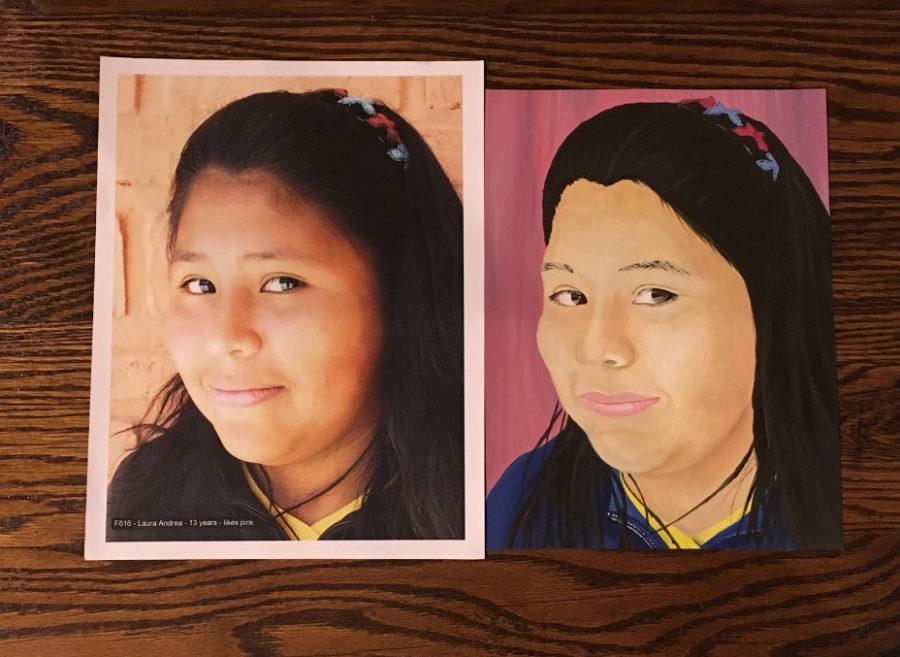Jill McDonnell surveyed a set of portrait pictures laid out on a Hillman Library table and picked her next art subject based on their name and favorite color — the only information provided with the picture.
Using watercolor and acrylic paints, McDonnell and 27 other artists at Pitt painted personalized portraits of children they haven’t met, which will be delivered next week to the subjects — 4,000 miles away in Bolivia.
“I chose this particular portrait to paint because her favorite color is pink — and that’s how I made the background,” McDonnell, a junior molecular biology major, said. “I also sent a note in Spanish with the portrait.”
Members of ARTificial –– a Pitt club McDonnell is involved in that focuses on providing outside the classroom art projects for students –– and other Pitt art students created these portraits for The Memory Project, a national nonprofit aimed at helping poor, abused or orphaned children feel valued by giving them a personalized portrait. The artwork is created by artists at high schools, colleges and other organizations around the country.
Each year, The Memory Project receives photos of disadvantaged children taken by various global charities and orphanages. The project then sends these pictures to schools or organizations that have artists interested in painting portraits for the children, only giving their first name, age, country they live in and favorite color. The project doesn’t reveal the organization that provided the photos to protect the children’s privacy. Each artist gets one photo, but each child gets two different portraits from two different artists.
Cara Pizzorusso, a sophomore marketing major, became involved with the project in high school and wanted to continue contributing at Pitt. By partnering with ARTificial and promoting the project in the art school, Pizzorusso formed a group at Pitt interested in working with the project.
“I thought it would be cool to bring to Pitt’s campus, not even as a club, but as a somewhat informal thing,” Pizzorusso said.
Ben Schumaker — a 2003 graduate of the University of Wisconsin-Madison — started The Memory Project in 2004 after he returned from volunteering in Guatemala. He noticed the children there had few special belongings and had no photos or videos to help remember their childhood.
Ryan Egan, communications director at the project, said the experience can be “compassion-building and empathy-building” for artists who dedicate their time to the program.
“It’s a connection formed that kind of transcends what we know in the human experience,” he said.
Schumaker said high school students create 95 percent of the portraits as assignments for class, making college groups like ARTificial — that draw and paint as volunteers — less common.
“The college students are almost always just hard working volunteers,” he said. “We really appreciate that they do this in their spare time.”
Sana Mahmood, president of Pitt’s ARTificial, was eager to get members of the club involved because The Memory Project’s goals reminded her of a visit she took to Pakistan. At her grandmother’s house, Mahmood, a biology, history of art and architecture and history in philosophy of science triple major, spent time with the daughter of a woman who helped around the house. To keep the young girl busy, Mahmood provided her with an adult coloring book and pencils, and she noticed how the little girl eagerly colored the intricate designs in the book. She realized the power of art to form connections and make memories.
This time, all the pictures The Memory Project sent to Pitt in February were of children from Bolivia. The artists at Pitt had six weeks to paint the portrait on some flat surface –– like paper or loose canvas–– that could be shipped easily. They used a variety of mediums, including more abstract methods like pixelating the portraits.
McDonnell decided to avoid the abstract form — which is creating from the idea of something rather than reproducing an exact replica — when composing the painting of the child she chose. Her high school art classes didn’t work with The Memory Project so she was eager to participate in the project at Pitt
“I’m more of a realistic artist,” McDonnell said. “I’m too much of a perfectionist to let myself do expressionistic stuff.”
After they are completed, the students mail the portraits and usually a group picture of all the artists from a region holding up their paintings, to Madison, Wisconsin, where The Memory Project is based. Staff members at The Memory Project deliver the portraits directly to the children and take videos and photos of their reactions to compile them into a video, Egan said. Egan and his wife Cheridyn will personally deliver the portraits to the children in Bolivia next week.
“It helps bring the whole circle together,” Egan said, referring to the reaction video. “It not only shows the compassion of the artists [because of the time they commit to their project], but it also shows the excitement of the children upon receiving the portrait.”
Each artist is required to pay a $15 fee for coordination and shipping of the portraits. Mahmood said the club plans to appeal to Student Government Board Allocations Committee for funding in the future.
When traveling to another country and experiencing a new culture, Mahmood said, it’s easy to realize that people aren’t that different. The Memory Project helps to form this connection of “one humanity,” by studying the portrait of someone’s face, she said.
“As much as you want to go abroad for a mission trip, it’s not always feasible and affordable,” Mahmood said. “So doing a little something like this is always better than nothing.”


